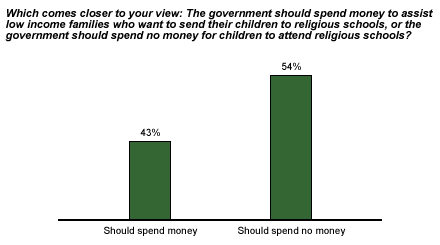In what will likely become a landmark case, the U.S. Supreme Court ruled on June 27 that a Cleveland voucher program, in which students' families receive state funds to put toward private school tuition, does not violate the Constitution, even though a majority of the schools receiving state funds are religion-based. Supporters of school vouchers view the decision as an opportunity for other states to adopt similar measures.
Separating Church and State
The American public appears reluctant to embrace vouchers. A recent Gallup poll* found that the American public is divided, but a majority believe that state funds should not go to religious schools.

Previous voter response in two states reflects similar sentiments. A voucher initiative was defeated in Michigan two years ago, and California residents voted twice against voucher proposals.
Public Education and Choice
Rod Paige, U.S. secretary of education, echoed the court's majority in a June 28 Washington Post editorial, saying that programs like the one in Cleveland provide needed educational alternatives to low-income families. Proponents argue that affluent parents possess the opportunity to seek private schools or move to areas with better schools, and that low-income parents and children have no means to escape low-performing schools.
Opponents counter that voucher programs siphon off the more involved parents, give financial resources that should be going to the public schools to private and religious schools and distract from reforms in public schools.
Both views are right, and both miss the point.
Public schools have provided upward mobility for generations of American students. They still do in many instances. But there is a crisis in today's public schools, particularly in large cities. Parents should not be forced to send their children to schools where students don't learn. Yet allowing choice for some students while keeping far greater numbers of others in failing schools cannot be justified either. We have a responsibility to all students.
Fix the Public Schools
The most crucial imperative is to fix the public schools. The American public understands this; in the latest PDK/Gallup Poll survey** of attitudes toward education, respondents were presented with a choice to reform existing public schools or find an alternative system. Seventy-two percent preferred reforming the public schools, while 24% said they would rather find an alternative system.
Today, schools must do far more than educate young people -- they are the instruments through which America reacts to social issues as varied as racial integration and the AIDS epidemic. Many of today's students have little or no support at home, and schools often shoulder the burden of before-and after-school care for working parents. School districts are highly politicized, and decisions are often based on political pressures, not necessarily on what is right for students. Three decades ago, if students dropped out of school, there were jobs for them. Today, fewer jobs exist for those without an education, thus adding to the pressure on public schools.
While all of these changes have made teaching in public schools more difficult, educators have not helped their cause. Statewide accountability testing may not measure what the schools teach, and the tests may not reflect what an educated person should know. But accountability tests exist because the education community failed to measure student progress adequately and report it to parents and the community. A similar result will occur if the education community ignores the issue of choice in public education in the hopes that this, too, shall pass.
Educators need to awaken to the fact that school districts and individual schools must provide stakeholder value just as corporations provide stockholder value. Citizens must see evidence of a good return on their investment. If they do not, then the rush to find alternatives to public school will increase in an ever-growing number of school districts, including the suburbs.
America needs a big plan for public schools. The time for tinkering with reform is gone. Providing parent choice for a relatively small number of students will not address the overarching problems in public education. Instead, America needs a significantly new vision of what schools in this country should become, and the leadership to provide that reality to all students. The future of millions of young people is at stake.
*Results are based on telephone interviews with 1,020 adults, aged 18 and older, conducted June 21-23, 2002. For results based on this total sample, one can say with 95% confidence that the maximum margin of sampling error is ±3%.
**Results are based on telephone interviews with 1,108 adults, aged 18 and older, conducted May to June 2001. For results based on this sample, one can say with 95% confidence that the margin of sampling error is ±3%.